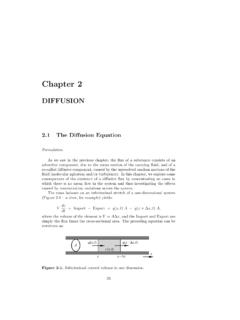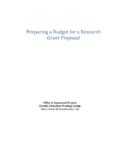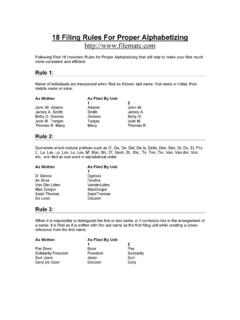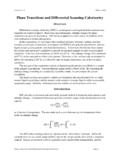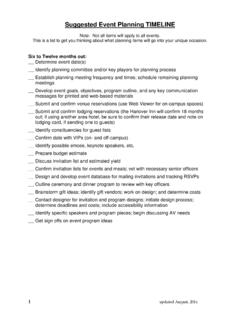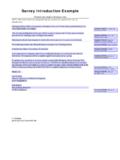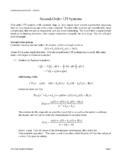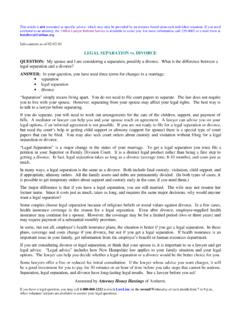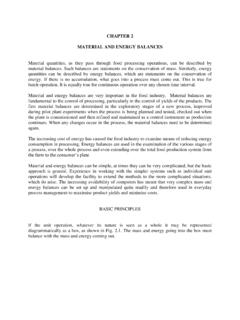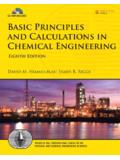Transcription of Chapter 1 Mass & Energy Balances - dartmouth.edu
1 1 chapter 1 Environmental Transport and Fate Mass & Energy BalancesBenoit Cushman-RoisinThayer School of EngineeringDartmouth CollegeTo extract useful quantitative information from a system, it is necessary to apply the laws of physics. The most important physical laws (for our purpose here) are:Conservation of mass mass of carrying fluid (air or water) mass of carried contaminant (ex. Mercury) mass of a relevant quantity (ex. dissolved oxygen)Conservation of Energy total Energy (mechanical + thermal) usually thermal Energy dominates2 Finite-volume budget methodologyStep1: Choose a control volumeThis can be the entire system or only a well-chosen piece of : Select the quantity for which the budget is to be madeThis can be mass of fluid or the mass of a contaminant. Be specific (For example: S or SO2?) Step3: Consider all contributions, positive and negativeAdd imports and subtract exports through i kithi tht llAdd sources and subtract sinks within the control of control volumesollege smokestackTurbulent jet in fluids lab at Cone around a smokestack plumeSection of a discharge jetDartmouth CoThayer SchoolFerguson lake, BrSection of a riverAn entire lakeWhite River, Vermontritish Columbia, Canada3 PhoenSometimes it is difficult to know where to place the boundaries ofix, ArizonaSometimes it is difficult to know where to place the boundaries of the control the case of an airshed: How high should the control volume be?
2 The general rule is: up to the top of the so-called atmospheric boundary layer. More on that choice of a control volume is more an art than a science, for there are countless possibilities. A good level of intuition is required, which can only be developed with this, there are a couple of basic rules that apply:1. A control volume ought to be practical, in the sense that it should yield budget equations with the minimum number of unknowns of the Its boundariesneed to be clearly defined so that there is no ambiguity about what is inside and what is outside and where are the fluxes in and out of the s do a budget for a generic quantity, of it as the concentration of a contaminant:cVmmc substance of masscVmVc fluid carrying of volumeIn words, the budget is:Accumulation= imports exports+ sources sinksWhat is addedWhat is removed fluidcarryingofvolumemass)()( duration )(at amount )(at amount onAccumulatidtdcVdttcVdttcVdttdtt outletsoutletsinletsinletspresent)(Amoun t constant)(Decay sinksnapplicatio toaccording specified be tosourcesareatimeareafluid carrying of volumevolumemassexportsareatime areafluidcarryingofvolumevolumemassimpor tscVKSQcQcoutoutinin outletsinletscVKSQcQcdtdcVoutoutininwher e V= volume of control volume (in m3)c= concentration of substance (in kg/m3)Q= uA= volumetric flux of fluid (in m3/s)S= sum of emissions (in kg/s)K= decay constant (in 1/s)5 Particular cases1.
3 Steady state: Concentration remaining unchanged over time iltSQcdcinin2. Conservative substance: No source(S= 0) and no decay(K= 0) outletsinletsoutletsinlets00 KVQcKVcSQcQcdtdcoutoutinincQQcdtdcVoutin in outletsinlets3. Isolated system: No import and no export(allQ s= 0)KteKVScKVStccVKSdtdcV initial)((if Sis constant over time)Mass conservationTo state mass conservation, we useAnd we state that there is no source and no sink. densityvolumemasscThe budget becomes: outletsoutoutinletsininQQdtdV Air and water in the environmental systems behave as incompressible fluids. Thus,constantoutin And the mass budget reduces to a volume budget: outletsoutinletsinQQNaturally !6 Example of Material BalanceA lake contains V= 2 x105m3of water and is fed by a river discharging Qupstream= 9 x104m3/year. Evaporation across the surface takes away Qevaporation= 1 x104m3/year, so that only Qdownstream= 8 x104m3/year exits the lake in the downstream stretch of the river.
4 The upstream river is polluted, with concentration c= mg/L. Inside the lake, this pollutant decays with rate K= volume Vof lake as the control steady state(= situation unchanging over time)Budget is:Budget reduces to:Solution is:mg/L )m 102( )(/yr)m 10(8mg/L) /yr)( (9)(0)( 353434downupupdownupupdowndowndownevapev apupup KVQcQccKVQcQccKVccQcQcQdtdcVVariation on the preceding exampleUn-aided (natural) remediationSuppose now that the source of pollution in the upstream river has been eliminated. The entering concentration in the lake has thus fallen to zero. Slowly, the concentration of the pollutant decays in the lake because of its chemical decay (Kterm) and flushing (Qterm). The equation becomes:cKVQdtdcKVccQcQcQdtdcV downdowndownevapevapupupThe solution to this equation )mg/L (exp)( 7 From this solution, we can see that:It takes years for the concentration to drop by 50%,If the acceptable concentration is mg/L, it takes 7 6 yearsit takes : If years is too long, what can be done?
5 Check time scales of the problem:Residency time = V/Q= (2 x105m3)/(8 x104m3/yr) = yearsDecay time = 1/K= 1/( ) = yearsConclusion: Decay is slow, flushing comparatively fast. Flushing is primarily responsible for the natural cleaning of the a chemical to speed up decay would only bring incremental change, while increasing the flushing rate would have greater example: The smoking room at the airport (adapted from Masters, 1997)A smoking room with an air volume of 500 m3is ventilated at the rate of 1000 m3/hr. When it l ki hii i id 0khikopens at 7 o clock in the morning, its air is pure and 50 smokers enter, each starting to smoke two cigarettes per hour. An individual cigarette emits, among other things, about mg of formaldehyde, a toxin that converts to carbon dioxide at the rate of the formaldehyde concentration at 8 and 9 o clock, and the steady the threshold for eye irritation is mg/m3, at what time does the smoke begin to irritate the occupants eyes?
6 We solve this problem by determining first the source of formaldehyde:hourmg140smokers50hour smoker SSince the entering air is presumably fresh, cin= 0, and there is no exiting concentration is the same as in the bar: cout= c, and the export is Qc,where Q= 1000 m3/hr is the ventilation rate, and cthe unknown indoor formaldehyde budget then takes the form:ScVKQdtdcV )(dtTaking t= 0 as 7am and the initial concentration c(t=0) = 0, fresh air when the room opens, the solution is tKVQVKQS tcexp1)(9 Sample numerical values are:With numerical values, this solution is ) (1) ()(3ttc (with texpressed in hours)at 8am (t= 1 hr):c= mg/m3at 9am (t= 2 hrs):c= mg/m3 The ultimate concentration (t= ) is3mg/m VKQSc VKQWe note that by 9am, the air in the room is almost as smoky as it will be for the rest of the address the eye irritation problem, we first compare the threshold concentration to the ultimate concentration.
7 Since the threshold concentration ( mg/m3) is less than the ultimate concentration ( mg/m3), the eye irritation level will be reached at some the previous solution, solving for time as a function of concentration, we can determine the time at which eye irritation begins:hours ctThat is about 18 minutes after people start smoking in the room!It is instructive to explore what action can be taken to remediate this problem by using the framework of source pathway on the part of students here ..10 Heat as a pollutant Need to consider Energy conservationIn the atmosphere and surface water, there are various forms of Energy : - kinetic (due to motion),- potential (due to elevation), and - thermal (due to heat content).Almost always, the thermal Energy dwarfs the other example: Heating 1 kg of water by 1oC takes 4184 JHeating 1 kg of air by 1oC takes 1005 J(at constant pressure)1 kg of air or water moving at 10 m/s has 50 Jof kinetic energy1 kg of air or water falling down 50 m releases 490 Jof potential energyThe result is that the Energy budget reduces in good first approximation to a heat budget:heat budget:Accumulation of heat = Heat entering Heat exiting + Heat sources Heat sinksFurthermore, sources and sinks are rarely internal but occur most often at boundaries.
8 Thus,Accumulation of heat = Heat entering Heat exitingHeat content = Thermal Energy = Internal energyTCmv Per unit volume:TCv Budget:m= mass of substanceCv= heat capacity of substanceT= temperature of substance = density of substanceBudget:outoutletsoutininletsino utoutoutletsoutinininletsin )()()()()(QTQTdtdTVAuTCAuTCTCdtdVvvv outletsinlets11 Example of heat as a pollutantMW 3000 PPControl volumeMW1700 MW300MW2000MW2000 MW1000MW3000river toheat waste PPHeat budget:Heat )2030)(4184)(1000(J/s101700)(MW1700MW170 0 water todeliveredHeat heat Entering heat Exiting36enteringexitingenteringexiting TTC QQTC QTC vccvcvdownstreamdownstreamdiverteddivert edupstreamupstream0 TQTQTQ Solve for Tdownstream: 203759306340 TThe power plant increases the river temperature by 4 degrees this is excessive, what can be done?
